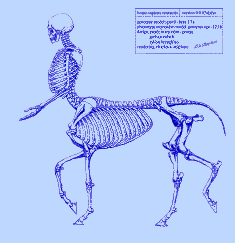
 Centaur Origins -
Centaur Origins -
 What is a centaur, anyway? -
What is a centaur, anyway? -
 Centaur Links
Centaur LinksThe Greek love for the horse led to the ennoblement of the centaur in myth and legend (the only version of the kallikantzaroi to be so honored). The Centaur Chiron was known for his wisdom and healing abilities. Other centaurs did not fare so well in myth: Nessus was killed by Hercules for trying to rape (variously) his wife or a woman under his charge, and other centaurs were renowned for their weakness for drink. The centauromachy - the depiction of one or more of the fights between humans and centaurs in myth - became a popular feature of Greek art. The centaur was also used by some writers to symbolize man's dual nature as an intellectual creature (the human half) which was also an physical animal (the horse half).
In the Medieval period, the centaur fared more poorly, often becoming a demonic image. Nevertheless, the centaur remained a popular character in art, no doubt due to the vast influence of Greek art and literature on Western culture.
In modern times, the centaur has reappeared in art and literature, especially in the genre of fantasy. C.S. Lewis' The Narnian Chronicles and Piers Anthony's Xanth series have prominent centaur characters. Science fiction has used the character as well; John Varley's Titan, Wizard, Demon series, Jack Chalker's Wellworld series, Walter Jon William's Knight Moves, Elf Sternberg's The Journal Entries series, and my own (as yet unpublished, gripe, gripe) homo centauris all feature prominent centaur characters.
 The Compendium -
The Compendium -
 Anthony Francis' Home Page -
Anthony Francis' Home Page -
 Picture Credits.
Picture Credits.